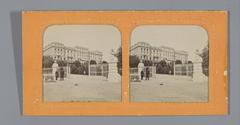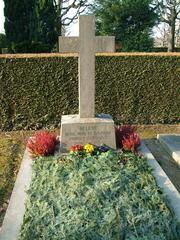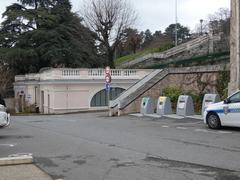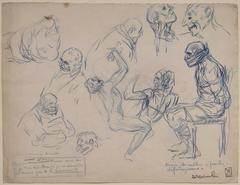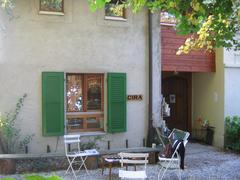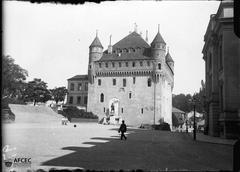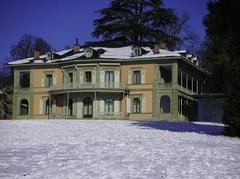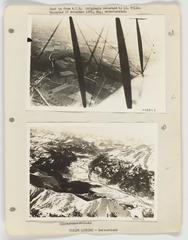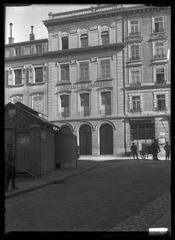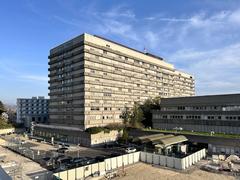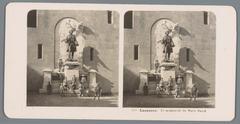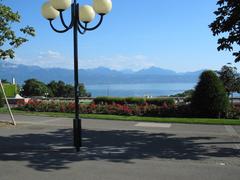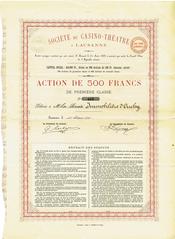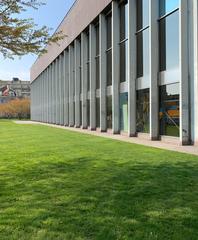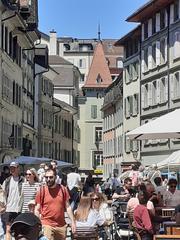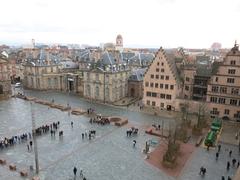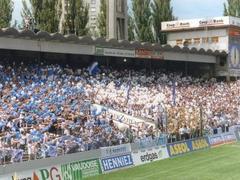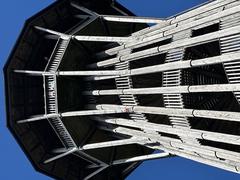Château d’Ouchy: Visiting Hours, Tickets, and Attractions in Lausanne
Date: 15/06/2025
Introduction
Château d’Ouchy is a striking architectural landmark nestled on the shores of Lake Geneva in Lausanne. Renowned for its blend of medieval origins and 19th-century neo-Gothic revival, the château stands as a testament to Lausanne’s rich heritage, international significance, and enduring elegance. Today, it operates as both a luxury hotel and a cultural site, offering visitors a seamless fusion of historic ambiance and modern amenities.
This comprehensive guide explores the château’s history, architectural evolution, cultural and Olympic connections, practical visitor information—including hours, ticketing, and accessibility—as well as nearby attractions. Whether you are a history enthusiast, an architecture lover, or simply seeking lakeside relaxation, Château d’Ouchy offers a memorable experience amid Switzerland’s most picturesque settings.
For official updates and detailed visitor information, consult the Château d’Ouchy website and Lausanne’s cultural heritage portal.
Table of Contents
- Introduction
- Medieval Origins and Early Development
- Neo-Gothic Transformation and 19th-Century Revival
- Architectural Highlights
- Political, Diplomatic, and Olympic Significance
- Cultural Role and Social Impact
- Practical Visitor Information
- Nearby Attractions
- Dining and Accommodation
- Events and Seasonal Tips
- Frequently Asked Questions (FAQ)
- Conclusion
- References
Medieval Origins and Early Development
Château d’Ouchy’s story began in 1177, when Bishop Landri de Durnes of Lausanne commissioned a fortified lakeside tower (chateaudouchy.ch; wikipedia). This initial structure served as both a symbol of ecclesiastical authority and a strategic outpost for controlling trade and movement along Lake Geneva. By the 13th century, the site had evolved into a fortified residence, with a central donjon (keep), ceremonial halls, and defensive walls—typical of the “châteaux de lac” style found throughout the region (lausanne.ch).
Throughout the Middle Ages, the castle was a seat of power for the bishops of Lausanne, later serving as a prison and granary. The structure suffered damage and neglect after the Bernese conquest in the 16th century and a major fire in 1609, leaving only the donjon intact by the 19th century (Wikipedia).
Neo-Gothic Transformation and 19th-Century Revival
The castle’s dramatic transformation occurred in the late 1800s, spurred by the rise of tourism following the arrival of the railway in 1856. In 1885, Jean-Jacques Mercier acquired the site and, in collaboration with architect Francis Isoz, undertook a complete reconstruction between 1889 and 1893. The project preserved the medieval donjon while reimagining the complex as a neo-Gothic palace and luxury hotel (chateaudouchy.ch; lausanne.ch).
The new design introduced pointed arches, decorative battlements, turrets, and stone tracery—evoking the romance and grandeur of medieval castles, while providing the modern comforts expected by 19th-century travelers (Trek Zone). Since its opening in 1893, Château d’Ouchy has stood as a symbol of Lausanne’s cosmopolitan appeal and architectural ambition.
Architectural Highlights
- The Donjon (Keep): The 13th-century tower is the only surviving medieval element, featuring thick stone walls and a crenellated parapet.
- Neo-Gothic Façade: Characterized by pointed arches, ornate stonework, and turrets, the façade creates a dramatic, romantic silhouette (lausanne.ch).
- Lakefront Orientation: Large windows and terraces offer panoramic views of Lake Geneva and the Alps.
- Historic Interiors: Period furnishings, stained glass, and wood paneling evoke the château’s layered history, while guest rooms blend historic details with contemporary luxury (chateaudouchy.ch; booking.com).
- Modern Amenities: The hotel features a wellness area with outdoor pool, sauna, hammam, and treatment room, all discreetly integrated into the historic structure.
Political, Diplomatic, and Olympic Significance
Château d’Ouchy has played a pivotal role in Lausanne’s international profile:
- Treaty of Lausanne: In 1923, the château hosted the signing of the Treaty of Lausanne, a key event in European diplomatic history (PlanetWare).
- Olympic Heritage: The castle is closely linked to Lausanne’s status as the Olympic Capital. Pierre de Coubertin, founder of the modern Olympic Games, held important conferences here, and the nearby villa “Mon-Repos” housed the first Olympic Museum (lausanne.ch).
- Conference Venue: The hotel regularly hosts diplomatic events, business meetings, and international gatherings, leveraging its prestigious setting and historical gravitas (myswitzerland.com).
Cultural Role and Social Impact
Château d’Ouchy is more than a hotel; it is a vibrant cultural and social hub:
- Art and Exhibitions: The lobby frequently features rotating exhibitions of local artists (slh.com).
- Events: The château is a popular venue for weddings, conferences, and citywide celebrations, including special fan zones during major sporting events (Lausanne Tourisme).
- Community Gathering: Its lakeside terraces and gardens are favored spots for both locals and travelers to enjoy Lausanne’s scenic beauty.
Practical Visitor Information
Visiting Hours and Tickets
- Hotel Lobby and Reception: Open daily from 7:00 AM to 11:00 PM.
- Restaurant and Terrace: Breakfast from 7:00 AM to 10:30 AM, lunch from 12:00 PM to 2:30 PM, and dinner from 7:00 PM to 10:00 PM.
- Guided Tours: Occasionally available; inquire at the hotel or check the official website for schedules.
- Tickets: No general admission ticket is required for the hotel lobby or restaurant. Special tours or events may require advance booking and a fee.
Accessibility
The hotel is wheelchair accessible, with ramps and elevators available. The lakeside promenade and surrounding parks are also accessible. Visitors with specific mobility needs should notify the hotel in advance (myswitzerland.com).
Getting There
- By Metro: Take Lausanne Metro Line M2 to Ouchy–Olympique station; the château is a short walk away.
- By Bus: Multiple lines connect the city center with Ouchy.
- By Car: Parking is available nearby, but may be limited during major events (Lausanne Tourisme).
Nearby Attractions
- Olympic Museum: Showcasing the history and spirit of the Olympic Games.
- Musée de l’Élysée: Renowned photography museum.
- Lausanne Cathedral: Gothic masterpiece in the city center.
- Lavaux Vineyards: UNESCO-listed terraced vineyards, accessible by public transport.
- Lake Geneva Cruises: Scenic boat trips departing from Ouchy port (Studying in Switzerland; PlanetWare).
Dining and Accommodation
- Château d’Ouchy Restaurant: Celebrated for refined cuisine and lakeside dining, open to both guests and visitors.
- Accommodation: Offers elegantly appointed rooms and suites with views of Lake Geneva and the Alps (One Day Itinerary; Michelin Guide).
- Nearby Restaurants: Options include L’Accadémia (Italian), La Brasserie du Royal (French), and La Croix d’Ouchy (Swiss/Mediterranean).
Events and Seasonal Tips
- Spring/Summer: Ideal for lakeside walks, boat cruises, and outdoor dining. Gardens and promenades are in full bloom.
- Autumn/Winter: The château offers a cozy retreat, with festive events and fewer crowds. Some outdoor amenities may be closed in winter.
- Special Events: Ouchy frequently hosts concerts, festivals, and fan zones, such as during the UEFA Women’s EURO 2025 (Lausanne Tourisme). Check local calendars for up-to-date information.
Frequently Asked Questions (FAQ)
Q: What are Château d’Ouchy’s visiting hours?
A: The hotel lobby is open daily from 7:00 AM to 11:00 PM. Dining facilities have set meal hours. Guided tours are available occasionally—check the official website for current offerings.
Q: Do I need a ticket to enter Château d’Ouchy?
A: No general ticket is required for the hotel lobby or restaurant. Tickets are only needed for special tours or events.
Q: Is the château accessible to guests with disabilities?
A: Yes, the hotel and public areas offer accessibility features. Some historic areas may have limitations—contact the hotel for details.
Q: How do I get to Château d’Ouchy from Lausanne city center?
A: Use Metro Line M2 to Ouchy–Olympique station or local buses. The château is within walking distance.
Q: Are there guided tours of the château?
A: Guided tours are occasionally available; inquire at the hotel or check the website.
Q: Can I book a room or a special event at Château d’Ouchy?
A: Yes, reservations can be made via the official website or trusted platforms such as the Michelin Guide.
Conclusion
Château d’Ouchy is a vibrant intersection of Lausanne’s medieval legacy, architectural innovation, and modern hospitality. Its commanding presence on Lake Geneva, storied history, and cultural significance make it an essential destination for anyone exploring Swiss heritage or seeking a luxurious lakeside retreat. With accessible amenities, proximity to top attractions, and a dynamic calendar of events, the château promises a memorable visit—whether for a meal, a stay, or a stroll through history.
Enhance your experience further by consulting official resources, downloading interactive guides such as the Audiala app, and staying updated on local events and exhibitions. Discover why Château d’Ouchy remains a highlight among Lausanne’s historical treasures.
References and Official Sources
- Château d’Ouchy Official Site, 2025, https://www.chateaudouchy.ch/en/welcome/
- Lausanne Cultural Heritage Portal, 2025, https://www.lausanne.ch/portrait/carte-identite/architecture-et-monuments/patrimoine-architectural/lausanne-1900/chateau-d-ouchy.html
- Trek Zone, 2025, https://trek.zone/en/switzerland/places/64986/chateau-douchy-lausanne
- Wikipedia, 2025, https://en.wikipedia.org/wiki/Ch%C3%A2teau_d%27Ouchy
- Lausanne Tourism, 2025, https://www.lausanne-tourisme.ch/en/accommodations/chateau-douchy/
- PlanetWare, 2025, https://www.planetware.com/tourist-attractions-/lausanne-ch-vd-lau.htm
- Audiala Mobile App, 2025, https://audiala.app
- Happy Little Traveler
- Studying in Switzerland
- One Day Itinerary
- Michelin Guide
- slh.com
